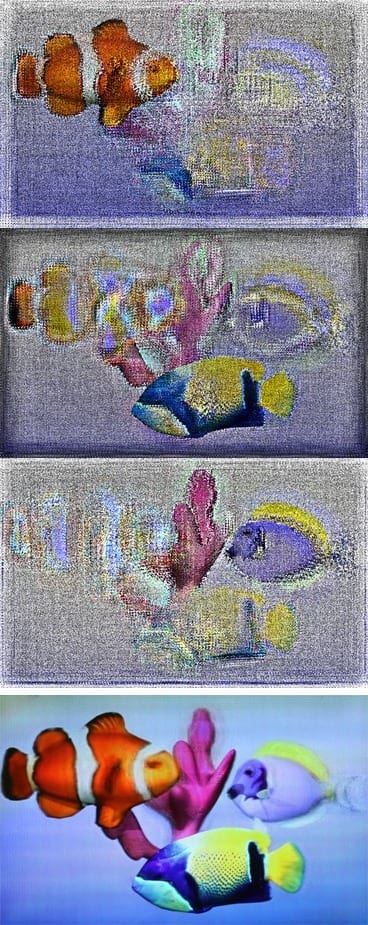
Using surface acoustic waves to control light’s angle and color composition, BYU and MIT researchers open door to inexpensive holographic video displays
Holographic video displays, featuring three-dimensional images, are about to “go large” and become a lot more affordable at the same time, thanks to the work of a team of Brigham Young University (BYU) researchers and their collaborators at Massachusetts Institute of Technology (MIT).
It’s all about manipulating light. Three of the primary methods include: reflection, refraction and diffraction. In this case, diffraction is the key, and essentially enables lines — almost any type — to bend and filter light.
In the journal Review of Scientific Instruments, from AIP Publishing, the team reports using surface acoustic waves as a dynamic pattern of lines to control light’s angle and color composition.
How does it work? The magic happens on the surface of a special crystal called lithium niobate (LiNbO3), which boasts excellent optical properties. Beneath the surface of the LiNbO3, microscopic channels, or “waveguides,” are created to confine light passing through. A metal electrode is then deposited onto each waveguide, which can produce surface acoustic waves.
The resulting frequency division of color enables a new type of color display. This means that “for a wavelength display, we don’t need to rely on color filter wheels or dedicated red and blue pixels,” explained Daniel E. Smalley, assistant professor of electrical engineering at BYU, who first reported an advance in this realm in Nature in 2013, while he was a graduate student working at MIT with his advisor V. Michael Bove.
Instead of a color wheel, any color combination is possible with their approach simply by altering the frequency of the signal sent to the “white waveguide pixel.” In other words, Smalley said, “we can color the output of our display by ‘coloring’ the frequencies of the drive signal.”
“As a bonus, this interaction also rotates the polarization of the signal light so that we can use a polarizer to eliminate any noise in the system,” he added.
In terms of applications, the team’s technology adapts and combines techniques from telecom and integrated optics in a way that makes it much less expensive than previous approaches. “We can use this technology to make simple and inexpensive color waveguide displays — including inexpensive holographic video displays,” Smalley pointed out. “This can drop the cost of a holographic video display from tens of thousands of dollars to less than a thousand.”
Holograms are meant to be large. Now that there’s a simple and inexpensive color display technology, Smalley and colleagues are working on ways to use it to create large holographic video displays — on the scale of room-sized displays.
Read more: The Future of Holographic Video
The Latest on: Holographic Video
[google_news title=”” keyword=”Holographic Video” num_posts=”10″ blurb_length=”0″ show_thumb=”left”]
via Google News
The Latest on: Holographic Video
- Here's How Arizona Science Center Is Taking Visitors Under the Seaon May 2, 2024 at 12:08 am
OceanXperience uses projection mapping and other technologies to create an immersive experience.
- X-Men ’97’s New Episode Has Great Cameos And A Badass Magneto Moment, But I’m Really Psyched By That Marvel Multiverse Tie-Inon May 1, 2024 at 1:50 pm
More importantly, while Bastion is meeting over video conferencing with other colluders, we see Doctor Doom, the Fantastic Four’s arch-nemesis, and Baron Zemo, one of Captain America’s main enemies, ...
- Devo robots? Group looks to future while marking half a centuryon May 1, 2024 at 9:21 am
As new documentary and album sum up band's first 50 years, the New Wave pioneers consider their next de-evolution into holographic avatars or touring heads in jars.
- South Korea to focus on growing console game industry in bold five year planon May 1, 2024 at 8:16 am
A major focus on the console game sector will be undertaken by South Korea over the next five years as they share details of a new plan to revive and bolster their game industry. As reported by Yonhap ...
- Hatteras museum to reopen, Beaufort boat show aheadon April 30, 2024 at 1:00 am
N.C. Maritime Museums system is readying for the reopening of the Graveyard of the Atlantic Museum in Hatteras and the annual Wooden Boat Show in Beaufort this weekend.
- Netflix and Meta Use Hologram Tech to Promote New Releaseson April 28, 2024 at 5:05 pm
Big companies like Netflix, Meta, and even Nescafé are increasingly relying on high-tech launch events to create buzz for new releases. Does it work and is it worth the money? Read on to learn more.
- Dune's VFX Team Had To Create A Whole New Technique For The Hologram Sceneson April 28, 2024 at 4:00 am
Denis Villeneuve and his crew added an extra level of visual flair to Dune's Hunter Seeker scene, which called for some VFX ingenuity.
- 5 Futuristic Smartphone Features That Would Be Gamechangerson April 27, 2024 at 3:15 pm
In its ideal form, this notion could let us perform all kinds of tasks with only the most minute of gestures. With a snap of your fingers, you could record a video on your phone's camera, then fire it ...
- The Hologram Moment: Rome Odunzeon April 26, 2024 at 3:14 pm
The Chicago Bears introduced Rome Odunze to his new team's fa base in an incredible way - by having him be in two places at one time! The Bears beamed Odunze live from Detroit into the Miller Lite ...
- The Hologram Moment: Caleb Williamson April 26, 2024 at 3:14 pm
The Chicago Bears introduced Caleb Williams to his new team's fanbase in an incredible way - by having him be in two places at one time! The Bears beamed Williams live from Detroit into the Miller ...
via Bing News











